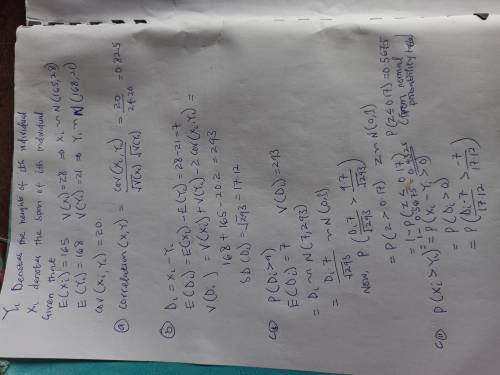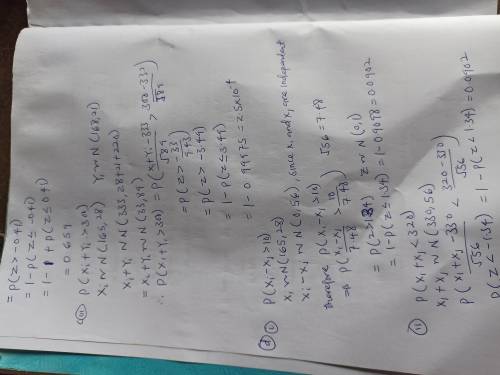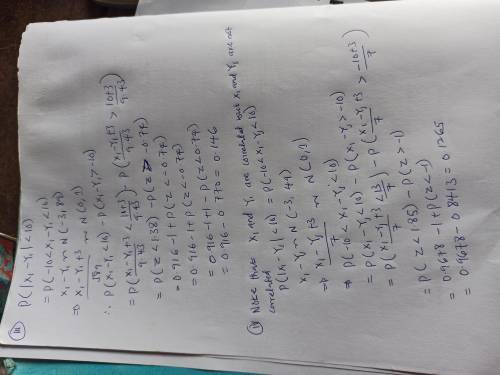
Mathematics, 07.05.2020 05:05 ryleerose255
Suppose that height Y and arm span X for U. S. women, both measured in cm, are normally distributed with means E(Yi) = 168, E(Xi) = 165, variances var(Yi) = 21, var(Xi) = 28, and covariance cov(Xi, Yi) = 20 for measurements on the same individual. For the purpose of this question, the variables are jointly normally distributed, and the values are independent for distinct individuals.
Part a: The correlation between height and arm span is .
Part b: The ‘albatross index’ is the difference Di = Xi − Yi between arm span and height. The mean of D is E(Di) = .
The standard deviation is sd(Di) =
.
Part c: Find the following probabilities for one individual: P(Di >9)= ;
P(Xi >Yi)= ;
P (Xi + Yi > 330) =
Part d: Consider now two specific unrelated individuals named i and j respectively. Compute the following probabilities:
P (Xi − Xj > 10) = ; P (Xi + Xj < 320) = ; P(|Xi −Yi|<10)= ; P (|Xi − Yj | < 10) = .

Answers: 1
Another question on Mathematics

Mathematics, 21.06.2019 17:00
Acylinder and its dimensions are shown. which equation can be used to find v, the volume of the cylinder in cubic centimeters?
Answers: 1

Mathematics, 21.06.2019 17:10
The number of chocolate chips in an 18-ounce bag of chocolate chip cookies is approximately normally distributed with a mean of 1252 chips and standard deviation 129 chips. (a) what is the probability that a randomly selected bag contains between 1100 and 1500 chocolate chips, inclusive? (b) what is the probability that a randomly selected bag contains fewer than 1125 chocolate chips? (c) what proportion of bags contains more than 1225 chocolate chips? (d) what is the percentile rank of a bag that contains 1425 chocolate chips?
Answers: 1

Mathematics, 21.06.2019 18:30
The volume of gas a balloon can hold varies directly as the cube of its radius. imagine a balloon with a radius of 3 inches can hold 81 cubic inches of gas. how many cubic inches of gas must be released to reduce the radius down to 2 inches?
Answers: 1

Mathematics, 21.06.2019 19:50
Prove (a) cosh2(x) − sinh2(x) = 1 and (b) 1 − tanh 2(x) = sech 2(x). solution (a) cosh2(x) − sinh2(x) = ex + e−x 2 2 − 2 = e2x + 2 + e−2x 4 − = 4 = . (b) we start with the identity proved in part (a): cosh2(x) − sinh2(x) = 1. if we divide both sides by cosh2(x), we get 1 − sinh2(x) cosh2(x) = 1 or 1 − tanh 2(x) = .
Answers: 3
You know the right answer?
Suppose that height Y and arm span X for U. S. women, both measured in cm, are normally distributed...
Questions


Mathematics, 31.03.2021 19:10



Geography, 31.03.2021 19:10

Mathematics, 31.03.2021 19:10

Mathematics, 31.03.2021 19:10

World Languages, 31.03.2021 19:10

English, 31.03.2021 19:10






History, 31.03.2021 19:10




Mathematics, 31.03.2021 19:10






